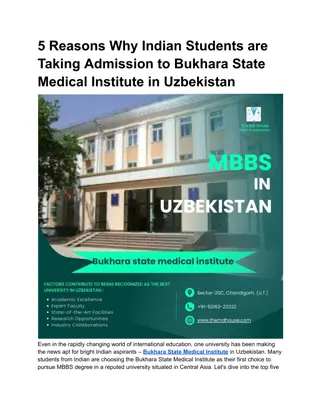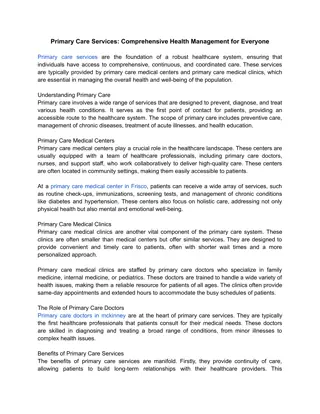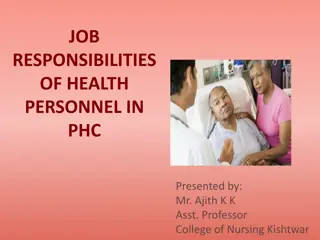Case Studies on Organization of Primary Healthcare Services in Indian States
Conducted as a follow-up on the PHC task force's recommendation, this compendium presents comparative case studies on organizations implementing primary healthcare approaches in India. The methodology involved desk reviews, site visits, interviews, and group discussions, focusing on reaching the poor and covering the entire population, rather than revenue maximization. Key observations from 15 case studies provide valuable insights, although the methodology has limitations that warrant further examination.
Download Presentation

Please find below an Image/Link to download the presentation.
The content on the website is provided AS IS for your information and personal use only. It may not be sold, licensed, or shared on other websites without obtaining consent from the author.If you encounter any issues during the download, it is possible that the publisher has removed the file from their server.
You are allowed to download the files provided on this website for personal or commercial use, subject to the condition that they are used lawfully. All files are the property of their respective owners.
The content on the website is provided AS IS for your information and personal use only. It may not be sold, licensed, or shared on other websites without obtaining consent from the author.
E N D
Presentation Transcript
: : , 2019 08 2019;
Case studies on organization of primary healthcare services in Indian states: an overview Chandrakant Lahariya, MBBS, MD, DNB, MBA, FIPHA National Professional Officer- Healthcare, Access and Protection World Health Organization India
Background Conducted as a follow up on recommendation of PHC task force (2015) A compendium of case studies on organizations implementing primary healthcare approaches
Methodology: Comparative case studies Mixed Methods: Desk review; site visits; interviews & group discussions Selection Criteria : Purposively selected, Focused on reaching the poor; Potentially replicable to cover entire population; Not focused on maximizing revenue
The case studies included (1/2) 1. Jan Swasthya Sahyog, Bilaspur, Chhattisgarh 2. The Healthspring Clinics; Mumbai 3. Public Private Partnerships in Uttarakhand 4. Deepak Foundation s MCH Center, Vadodara, Gujarat 5. Aravind s Eye Care, Madurai, Tamilnadu 6. St. Stephens Community Health Center, Delhi 7. Mission Hospitals & facilities: Holy Cross Hospital Kunkuri, Jashpur, CG; Duncan Hospital, Ruxaul, Bihar; Christian Fellowship Hospital, Oddanchatram, TN; Good Samaritan Hospital, Amboory, KE
The case studies included (2/2) 10. Shaheed Hospital, Dilli Rajhara, Chhattisgarh & Peoples Polyclinic Nellore, Andhra Pradesh 11. JIPMER, Puducherry 12. King Edwards Memorial Hospital (KEM), Mumbai 13. Urban Healthcare: Mohalla Clinics of Delhi 14. District Hospital, Shillong, Meghalaya, 15. Government Primary Health Centers from 4 states: Meghalaya; Maharashtra, Tamil Nadu, Kerala
Being mindful of limitations A methodology (comparative case studies) which is ranked lower in hierarchy of evidence At times, the teams followed variable approaches for documentation Qualitative focus with limited quantitative data Mostly documentation focus, with limited analysis Thus, observations presented need further & detailed examination.
Key observations from 15 case studies
1. Higher utilization of facilities when packages of services were comprehensive As was the case for all not-for profit That was done through conscious effort to make comprehensive. PPP models and Govt PHCs were selective Assured provision (limited gap in intention and provision); a possible explanation for popularity of the provision of primary healthcare at tertiary care facilities
2. Well performing facilities were better harmonized with secondary level of services A functioning referral system Functioning mechanisms for ensuring continuity of care JSS, specifically for chronic diseases, followed an approach of formulating a treatment plan in consultation with two levels Aravind Hospital efficiently used tele-medicine approach to ensure continuity of care Having strong provision of PHC system but not sufficient services at secondary level does not work
3. Assuring basic level of quality standards improve patient attendance (possibly, satisfaction) None of the non-govt case studies had a formal quality standard certification including most advanced Aravind eye care system. Govt PHCs in 4 states, which were considered as best facilities had met some quality standards. Experience shows that meeting a quality standard for Govt facilities increase patient attendance
4. Innovative & creative approaches to HR gaps Critical mass & mix of health workers, depending upon type of services, was considered essential. Except doctors, all other cadres locally recruited and trained or both. Sometimes certified in-house or through a formal system. Most did innovations to attract and retain right numbers and skill mix How to attract specialist and how much additional to pay (Deepak Foundation) Many used a different cadres (i.e. Nurse practitioners) of healthcare providers
5. Under-utilized computer based Health Information system Most had software and use of technology for billing & diagnostic reports. A few had customized software for specific purpose. (Aravind eye care) Many had recognized role of digitization in continuity of care (at two levels) & across time (at same level) Paper based system?
6. Leadership and motivation at small scale; & political will at large scale Motivation and performance at work was largely dependent upon the vision of the leadership Reportedly, staff motivation was ensured through selection process by finding motivated individuals Most created a work culture, where people fulfilled their responsibilities An extended interpretation could be the need for stronger political will, at larger level and for government health systems
7. Community engagement and participation Most case studies have reported some form of community partnership and engagement Role of community in NCD prevention was encouraged by a few facilities. Community engagement was higher in case studies focusing upon social determinants as well
8. Access & choice of technology & a climate of innovation Challenge in service delivery were attempted to be tackled through local and frugal innovation. Specially in case of JSS, there were innovations documented for infection free environment; lowering cost of diagnostics and ICT for continuity of care Aravind eye care system has done a few technological innovations including indigenously manufactured IOL & eye suture.
Case study on Govt Primary Health Centres in 4 states 10 facilities in 4 states: Kerala, Tamilnadu, Maharashtra and Meghalaya Purposive selection, in consultation with state official; considered amongst the best by the states Common features : (a) assured package of (though limited) services with a few additional packages offered; (b) sufficient availability & mix of providers; (c) continuum of care for services available; (d) most had some form of certification in quality standard; (e) stronger local level leadership; & (f) community engagement.
A lot more has happened since 2017 onwards Mohalla Clinics of Delhi, 2015 Innovations; PPP and community engagement Family Health Centres (FHC), Kerala, 2017 Engagement of PRIs and elected representatives Basthi Dawakhana, Telangana, 2018 Arguably, the first ULB led community clinics in India Health & Wellness Centres (HWCs) under Ayushman Bharat For entire country and both rural and urban areas
The road ahead There have been attention on specific & detailed documentation of similar case studies (in last 2 years) Possibly, time for institutional mechanisms for robust documentation and evaluations of models of PHC (both rural & urban) Possibly for broader health systems research
A case for Institutional mechanism for implementation and health systems research in India Case studies have underscored many unanswered policy questions on motivation, leadership, HR etc., There is strong case for institutional mechanism for implementation research, where policy questions are identified and solutions explored. Such documentation to be supported by academic rigour of evidence collation, synthesis & analysis for policy solutions. This need to happen at both national and state level with sufficient opportunities for cross learning and sharing.
In Summary Case studies gives an overview of the diversity of models for PHC that exists in India. Good and/or popular models have some common characteristics. For purpose of comparison, conclusions and ongoing learnings; more documentation, HS research & evaluations are needed. Implementation and health systems research in India may need institutional mechanism supported by all stakeholders. Might be helpful as India scale up of HWCs.
Acknowledgement Dr T Sundararaman, Formerly at TISS, Mumbai All authors of these case studies Organizations and facilities covered under this study Dr Rajani Ved and team NHSRC Dr Hilde De Graeve, WHO India MoHFW, Govt of India
2019 : : , Thank you very much























